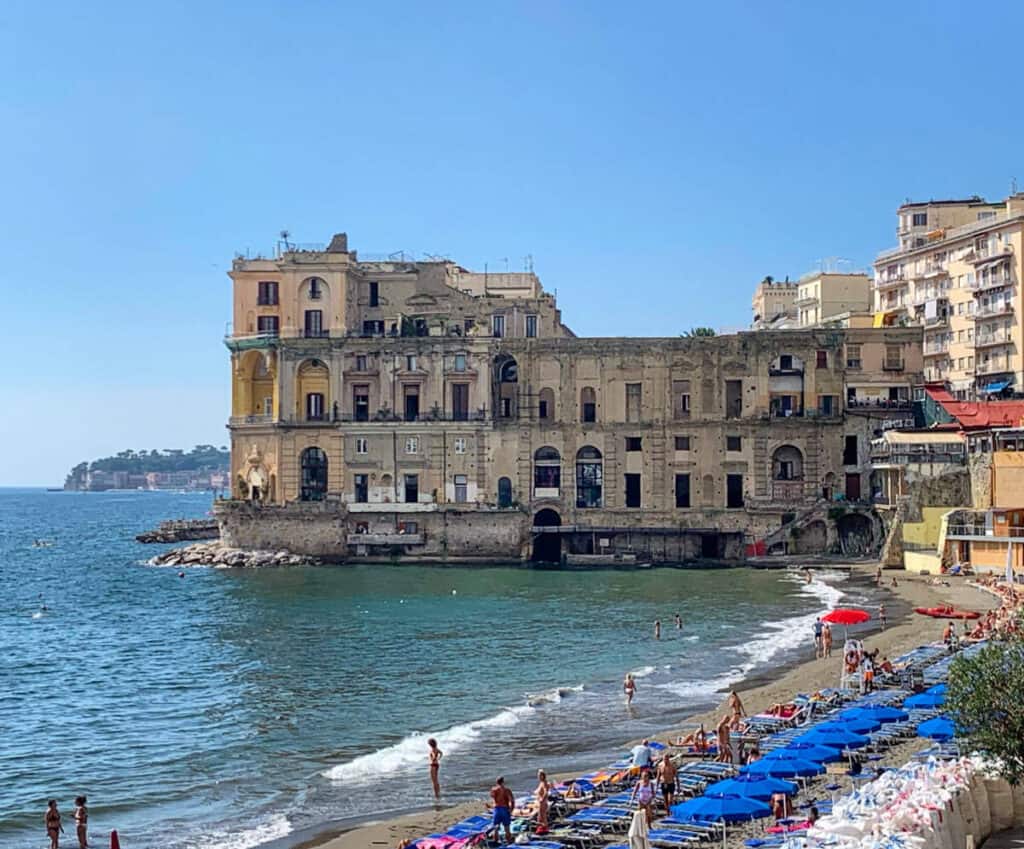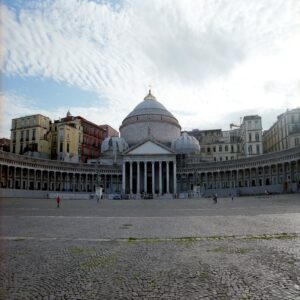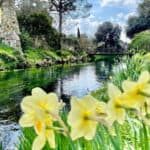How to spend the perfect 2 days in Naples
Naples: A perfect harmony of controlled chaos. You’ve heard the name before, usually before words like “pizza” or “coffee” or “pastries”, but ultimately, Naples is so multidimensional and lively that it cannot be summed up in a few key words. A stroll up one of the numerous hillside streets will reveal the animated spirit of this Southern Italian city nestled on the Campanian seaside and only an hour’s train journey from Roma Termini!
The best recommendation I can give you for discovering the true face of Naples is to walk. Begin your day bright and early and witness the sun rise over Spaccanapoli, Naples’ central street that literally means “to break Naples” and which divides the city into East and West. Mopeds whip down this street with carefree abandon, passing a seemingly infinite array of coffee shops boasting fresh pastries which draw passersby inside with the delicious scent of sfogliatelle and babà. There are plenty of places to try Naples’ signature sweets, and, of course, drink lots of coffee.

What to see in Naples
Naples has no shortage of incredible churches, museums, and piazzas, and while it may prove difficult to visit each one, we recommend that you put these on your itinerary:
Cappella di San Severo
Via Francesco De Sanctis, 19

The Capella Sansevero is an unmissable spectacle of baroque ingenuity in Naples. Elaborate marble facades line the chapel, which dramaticize the true treasure of the chapel in the center of the structure: the Veiled Christ statue, designed by Giuseppe Sanmartino in 1753. Sanmartino’s masterful touch transformed blocks of marble into soft cloth draped over Christ’s immortalized body. The impeccable details, from the delicate lace of the veil to the wounds on the hands and feet from the nails are breathtaking – it is a spectacle not to be forgotten.
Monastero di Santa Chiara
Via Santa Chiara, 49C

The Monastero Santa Chiara is a myriad of color and design that captivates, enchants, and calms the soul all at once. The outer walls and columns of the monastery, known as the Majolica Cloister, are decorated with detailed mosaic tiles adorned with vegetal and floral motifs. Inside, buttresses and nativity scenes give life to the monastery which was erected beginning in 1310. There is also an opera museum and archeological area in the monastery, so be sure to dedicate at least an hour to exploring all dimensions.
Duomo di Napoli
Via Duomo, 147

The interior of Naples’ Duomo is wrapped in an impressive facade of frescoes depicting various scenes from the Bible which are adorned by gold accents and impressive buttresses. Stand and admire the dramatic channel of the main chapel for a while, and then turn to the right to glimpse San Gennaro’s skull, who is the patron Saint of Naples. Entrance is free, and the cathedral is open from 8-12:30 and again from 4:30-7pm. Since you are already at the Duomo, I would suggest you check out the museum of the treasure of St. Januarius (Tesoro di San Gennaro), which is held right next to the Duomo. It leads you in a time travel through the collection of incredible masterpieces donated by devotees. In 700 years it was formed a treasure composed by jewels, paintings, sculptures, statues, silver furniture and textiles.
Castel dell’Ovo
Via Eldorado, 3

Constructed in the 15th century, legend tells us that this seaside castle was named by the poet Virgil after he hid an egg (ovo means egg in Italian) in the dungeon of the palace and asserted that the fate of the castle depended on the state of that egg. Enter into its domain for a glimpse of the city and surrounding harbor. Entrance is free and visiting hours are from 9am to 7pm on weekdays and 9am to 1pm on Sunday.
Piazza Plebiscito

The Piazza Plebiscito is a rare haven of stillness in the city of constant motion. The sprawling square, which gazes out upon the Basilica di San Francesco di Paola and the Royal Palace, is accented with sleek, symmetrical columns of marble that hug the piazza in a perfect semicircle. The piazza was once a center of political identity in Naples, meant to impress visitors and foreign diplomats with its grandeur. Today, it is occupied by afternoon strollers who wish to admire the impressive architecture of this storied piazza.
Certosa di San Martino
Largo S. Martino, 5

Perched atop a hill, this site is one of the most visible landmarks in the city and provides stunning views of Napoli from above. The Certosa di San Martino began construction in 1325 and has received numerous renovations since its founding. Gothic elements can be seen underneath the dominant baroque style, due to the work of architect Giovanni Antonio Dosio’s modernisation of the former monastery in 1581. The monks were forced to leave in the early 19th century due to French occupation, and since 1866 the site has been open to visitors who want to admire the baroque architecture and stunning presepe (Nativity) scenes.
Quartieri Spagnoli

If you veer off the main shopping street of Via Toledo into the Quartieri Spagnoli, you’ll be met with a true vision of life and the dynamism of Naples. Locals flock around tiny bars sipping even tinier cups of espresso, neighbors wave to one another from third-or-fourth-floor terraces, and children pass calcio balls back and forth atop uneven cobblestone streets. If you keep your eyes open, you may even witness the inventiveness of Naples’ residents who often lower buckets from an apartment terrace to the street using a pulley system to collect deliveries efficiently and swiftly. If the Naples you imagine is one strung with laundry lines climbing three stories high, or burly men munching on delicate pastries at all hours of the day, then you will find this side of the city in the Quartieri Spagnoli. Just watch out for the mopeds!
Lungomare di Napoli

Not every city can offer both a bustling metropolitan center as well as a calming seaside stroll with rolling hills in the horizon. The lungomare (seafront) of Napoli is perfect for an afternoon passeggiata along the ocean. Along the route, there are a number of bars and restaurants to stop and grab a drink before continuing on your walk. Four streets make up this beloved stretch of shoreline: Via Nazario Sauro, Via Partenope, Via Caracciolo, and Via Mergellina.
The best coffee in Naples
Evidently, the first thing you will want to do when you emerge from Naples Central Train Station is follow the scent of sweet, roasting coffee beans to the nearest coffee bar for a taste of the coffee that the world loves to rave about. There are many claims as to why Neapolitan coffee is the best in Italy – from the city’s custom of serving espresso in a warmed cup to the attentive grinding and brewing processes – and there is no doubt that Neapolitans are proud of their tiny cups of warm, strong espresso. We suggest you go for a traditional caffe taken at the bar, like locals do. However, it is also pleasant to pay extra for a table and watch the harmonious frenzy of the city pass by. Don’t forget to order a caffe sospeso before you go – Napoli began the tradition in Italy of pre-purchasing a coffee and leaving behind the receipt for someone in need.
Where to get your fix:
- Gran Caffe Gambrinus – Via Chiaia, 1/2 (Plebiscito)
- Cafè do Brasil – Via Luca Giordano, 31 (Vomero)
- Bar Mexico – Piazza Garibaldi, 72 | Piazza Dante, 86 | Via Alessandro Scarlatti, 69
- Caffè del Professore – Piazza Trieste e Trento, 46 (Plebiscito)
Sweets

Napoli is famous for its unique style of pastry and decadent sweets accented with ricotta, rum, and candied fruits. The epitome of such delicacies are the sfogliatelle, made with semolina, ricotta, sugar, eggs, and candied fruit, while the wrapping changes. The Riccia with puff pastry, the frolla with shortcrust pastry. The sfogliatelle were invented to resemble a monk’s cowl, and date back to 17th century Amalfi where they were first created in the convent of Santa Rosa.
Another icon of Neapolitan sweets is the babà, a soft, syrup-drenched cake with a mushroom-like shape. To make this classic treat, dough is leavened for an extensive period and then baked in an extremely hot oven. The cooled cake is then soaked in rum, limoncello, or sugar syrup, resulting in an unapologetically sticky dessert packed with flavor.
Where to sample the sweets:
- Scaturchio – P.zza San Domenico, 19 | Via L.Giordano, 79 | Piazza Amedeo 4/5 | Piazza Trieste e Trento
- Pasticceria Poppella – Via Arena Alla Sanità, 24 | Via Santa Brigida, 69/70
- Pasticceria Capparelli – Via dei Tribunali, 325
- Carraturo – Via Casanova, 97
- Sfogliatella Mary – Galleria Umberto
Where to eat pizza in Naples

At this point, you’re probably only thinking about one thing: pizza. After a day of exploring churches and the labryth of streets that makes up this city, nothing tastes better than an authentic Neapolitan pizza. It seems to be universally agreed upon within Italy that Neapolitan pizza is uniquely incredible. This is probably due to the use of buffalo mozzarella, which is produced in the surrounding hills of Campania. Or perhaps it’s the sweetness of the prized San Marzano tomatoes grown between Naples and Sorrento that make this city’s pizza so unforgettable. Whatever the secret may be, it’s no surprise that pizza is at the top of our list for Napoli – you only have to try it for yourself to understand the reason why.
- Di Matteo– Via dei Tribunali, 94
- Da Attillio– Via Pignasecca, 17
- Concettina Ai Tre Santi– Via Arena della Sanità, 7 Bis
- Antica Pizzeria Da Michele– Via Cesare Sersale. 1
- Sorbillo– Via dei Tribunali, 32
- 50 Kalò– Piazza Sannazaro, 201/c
How to get to Naples from Rome
Train from Rome to Naples
Taking the train is easy from Rome’s Termini station, which will get you to Naples in around 1 hour and 10 minutes (tickets are from €25).
CHECK THE TRAIN SCHEDULE FROM ROME TO NAPLES AND BUY THE TICKETS
Driving to Naples
Driving to Naples is a good idea If you want to visit the surrounding area, from the Amalfi Coast to Pompeii.





